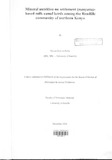| dc.description.abstract | A study was done to investigate the sources of minerals and mineral status of the
manyatta-based camels in Marsabit district of Kenya.
To document the existing indigenous knowledge on mineral nutrition in camels in the
study area, a survey was conducted using a questionnaire. Thirty-three, 28, and 30
respondents were individually interviewed in Kargi, Korr and Ngurunit locations of
the district respectively during dry and wet seasons. The respondents included men
and boys who were responsible for herding, watering and the general management of
camels. During the interviews, important mineral sources for the camels were
identified and ranked. The ranking of the identified forage sources was verified
through direct field observation of grazing camels.
The mineral sources (water, commercial supplements) and the important feed sources
were all sampled for analysis of minerals. The feed resources were also analyzed for
CP and fibre to generate supplementary information on their nutritive value. During
the survey, blood was sampled from a total of 90 and 88 camels during the dry and
wet seasons, respectively. The mineral sources and blood samples were assayed for
Na, K Ca, P, Mg, Zn, Cu, Fe and Co.
A combination of rainwater standing on salty soils referred to as marmar, and forages
growing on such soils were the key sources of mineral supplements to manyatta-based
camels, with commercial mineral supplements playing only a minor role. Salty water
and forages located within a 15 km radius from the manyatta were used mainly during
the wet season, while commercial salts were used during dry periods. Natural salty
water springs and moderately salty boreholes were also used during the dry season.
Over 80% of preferred forage species had Ca, P, Mg, K, Na, Fe and Co contents
above the recommended levels during both dry and wet seasons in all the study sites.
Eight and 38% of the forage samples were adequate in Zn and Cu, respectively. In
comparison with the recommended levels in water, natural springs water had
moderate levels of P and Fe, whereas standing rainwater contained reasonable levels
of Ca and Fe. Some of the preferred forage species and water sources had limited
temporal availability or were located outside the normal grazing radius of settlementbased
camels. Plasma levels of Ca, Na, Fe, Zn and Cu were lower than the reported
levels. The mean CP and NDF contents of preferred forage species were 13.9±5.0%
and 53.6±13.7% ofDM, respectively.
Rendille pastoralists were aware of the importance of mineral supplementation and
could describe the deficiency signs. Forages were the most important sources of
minerals for grazing camels followed by water. Apart from Cu and Zn, the forages
could potentially satisfy the daily requirements of camels for the studied minerals.
The combination of forage species selected by the camels across sites and seasons was
adequate in CP content.
After identification of the potentially deficient minerals, an intervention study was
conducted in Ngurunit and Kargi locations to determine the effect of mineral
supplementation on milk yield, calf growth and plasma mineral concentrations of
settlement-based camels. Two mineral supplements were formulated; one comprised
of locally collected, ground bones mixed with locally available natural salt and the
other of commercial ingredients, mainly sulphates of the respective mineral elements.
Fifty-nine and 56 camels in early lactation and their calves were recruited at Kargi
and Ngurunit, respectively. Of these, 22 and 21 camels were randomly assigned the
commercial supplement, while 12 and 11 were assigned the local supplement at Kargi
and Ngurunit, respectively. There were 25 and 23 control camels in Kargi and
Ngurunit, respectively. Each dam was individually fed 200g of mineral supplement
daily for 190 days. During the data collection period, milk yield measurements were
taken at weekly intervals and calves weighed monthly. Blood samples were also
collected on monthly basis for mineral assay.
The supplemented camels produced more milk (p < 0.05) than controls in Ngurunit
(3.2Id-1 versus 2.3Id-1). In Kargi, the mean milk yields for supplemented and control
camels were the same (2.6Id-1). Calves from the supplemented dams had higher
growth rate (p < 0.05) than the controls, gaining 441.3gd-1 and 424.8gd-1 compared
with 275.7gd-1 and 307.7gd-1 for controls in Kargi and Ngurunit, respectively. There
was no direct relationship between the supplement and plasma mineral concentrations.
From the results, it appears that mineral deficiencies do exist among the Rendille
camels. However, this problem could be reduced by judicial use of locally available
raw materials. Factors other than the supplements, which may include but not limited
to homeostasis and mineral interactions, appeared to playa more significant role in
determining mineral status in the blood. | en |

